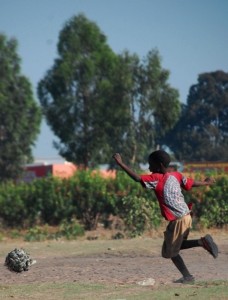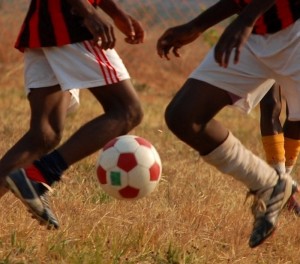By its very nature sport is about participation, inclusion, citizen- ship; it brings individuals and communities together. Sport provides a forum to learn skills such as discipline, confidence and leadership and it teaches core principles such as tolerance, cooperation and respect and at the same time the value of effort and how to manage victory as well as defeat.
 Internationally, the link between sport and development started with the Olympic movement in the early 20th century. However, it was only in the late 1990s that governments, UN agencies and NGOs started to employ sport more systematically in order to achieve social development out comes. The potential of sport as a tool for development and peace has yet to be fully realised, it has remained for years outside the mainstream of thinking and al- though it had been previously acknowledged as a human right, it was often considered a by- product of development, not an engine.
Internationally, the link between sport and development started with the Olympic movement in the early 20th century. However, it was only in the late 1990s that governments, UN agencies and NGOs started to employ sport more systematically in order to achieve social development out comes. The potential of sport as a tool for development and peace has yet to be fully realised, it has remained for years outside the mainstream of thinking and al- though it had been previously acknowledged as a human right, it was often considered a by- product of development, not an engine.
Since the establishment of the United Nations Inter-Agency Taskforce on Sport for Development and Peace, sport has been recognised as viable and practical low-cost and high-impact tool to support the accomplishment of the Millennium Development Goals, highlighting its role mainly in education, health issues and HIV/ AIDS awareness, the promotion of gender equality and women empowerment, but also its contribution to the achievement of all targets.
The involvement in sport for development and peace programmes of national governments, international agencies, NGOs as well as national and international sport federations and local grassroots organisation, is considered of vital importance.
DEFINITION OF SPORT:
In 2003, the UN Inter-Agency Task Force on Sport for Development and Peace defined sport as: “all forms of physical activity that contribute to physical fitness, mental well-being and social interaction, such as play, recreation, organized or competitive sport, and indigenous sports and games.”
This is a slightly abbreviated version of the definition given in the European Sports Charter (2001): “Sport means all forms of physical activity which, through casual or organized participation, aim at expressing or improving physical fitness and mental well-being, forming relationships or obtaining results in competitions at all levels.”
CONTRIBUTION OF SPORT TO THE MILLENNIUM DEVELOPMENT GOALS (MDGS)
Source: Harnessing The Power of Sport for Development and Peace: Recommendations to Governments, ©Right To Play on behalf of the Sport for Development and Peace Working Group, Toronto: 2008
 Sport represents a significant source of potential for enhancing and even accelerating development and peace efforts worldwide, particularly those related to attaining the MDGs. Sport’s attributes make it a valuable component of broader, holistic approaches in reaching the eight MDG benchmarks with targets aimed at:
Sport represents a significant source of potential for enhancing and even accelerating development and peace efforts worldwide, particularly those related to attaining the MDGs. Sport’s attributes make it a valuable component of broader, holistic approaches in reaching the eight MDG benchmarks with targets aimed at:
- Eradicating extreme poverty and hunger,
- Achieving universal primary education,
- Promoting gender equality and empowering women,
- Reducing child mortality,
- Improving maternal health,
- Fighting HIV, AIDS, malaria, and other diseases,
- Ensuring environmental sustainability,
- Developing a global partnership for development.
Sport’s Unique Value as a Tool for Development and Peace
The concept of Sport for Development and Peace is rooted in the recognition that sport possesses unique attributes that enable it to contribute to development and peace processes. These attributes include:
- Universal popularity – transcending of national, cultural, socio-economic and political boundaries, when done right, sport is enjoyable for participants and spectators alike and can be invoked in virtually any community in the world.
- Capacity as a powerful global communications platform – Because sport events offer the capacity to reach vast numbers of people, they are effective platforms for public education & social mobilization.
- Ability to connect – sport is an inherently social process bringing together players, teams, coaches, volunteers & spectators.
- Cross-cutting nature – sport can be used to address a broad range of social and economic challenges.
- Potential to empower, motivate and inspire – sport has the natural ability to draw on, develop, and showcase individual strengths and capacities.
Development and Peace Benefits Achievable Through Sport
1) Promoting health and preventing disease
- Prevents and manages chronic disease
- Prevents and manages infectious disease
- Enhances mental health
- Reduces direct and indirect health care costs
2) Enhancing the inclusion and well-being of person with disabilities
- Reduces stigma
- Enhances socialization
- Enables independence and participation
- Contributes to empowerment
- Fosters greater inclusion
3) Enhancing social inclusion, preventing conflict, and building peace
- Promotes social inclusion
- Provides respite in periods of conflict
- Builds trust and establishes bridges between groups in conflict
- Builds peace in a post-conflict situation
- Promotes a culture of peace
4) Strengthening child & youth development and education
- Enhances physical health and development
- Fosters psychosocial health and development
- Builds life skills and positive values
- Helps children and youth recover from trauma
- Strengthens education
5) Promoting gender equity and empowering girls & women
- Enhances girls’ and women’s health and well-being
- Fosters self-esteem and empowerment
- Facilitates social inclusion and integration
- Challenges gender norms
- Provides opportunities for leadership and achievement
TABLE 1
Contribution of Sport to the Millennium Development Goals
Source: Harnessing The Power of Sport for Development and Peace: Recommendations to Governments, ©Right To Play on behalf of the Sport for Development and Peace Working Group, Toronto: 2008
|
MILLENNIUM DEVELOPMENT GOAL |
CONTRIBUTION OF SPORT |
| 1. ERADICATE EXTREME POVERTY AND HUNGER |
|
| 2. ACHIEVE UNIVERSAL PRIMARY EDUCATION |
|
| 3. PROMOTE GENDER EQUALITY AND EMPOWER WOMEN |
|
| 4. REDUCE CHILD MORTALITY |
|
| 5. IMPROVE MATERNAL HEALTH |
|
| 6. COMBAT HIV AND AIDS, MALARIA, AND OTHER DISEASES |
|
| 7. ENSURE ENVIRONMENTAL SUSTAINABILITY |
|
| 8. DEVELOP A GLOBAL PARTNERSHIP FOR DEVELOPMENT |
|
